India's Third Giant Leap
This Could be One of the Biggest Opportunities for Investors
- Home
- Views On News
- Apr 22, 2023 - India's Top Renewable Energy Stocks: Big Returns or Boring Returns?
India's Top Renewable Energy Stocks: Big Returns or Boring Returns?
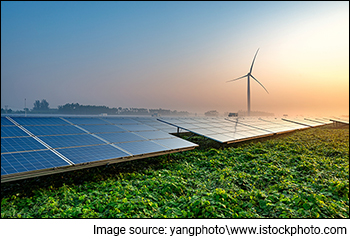
The renewable energy theme is considered to be one of the biggest investment themes.
A lot of money is being invested in capturing the growing demand. This has led to a surge in interest among investors looking for opportunities in the sector.
However, the question remains whether investing in renewable energy stocks can lead to big returns or just boring returns.
In today's article, we will take a closer look at the top renewable energy stocks in India, their growth potential, and how they have fared on the bourses.
#1 Indian Energy Exchange (IEX)
First on this list is Indian Energy Exchange (IEX).
IEX is a power exchange, licensed by the Central Electricity Regulatory Commission (CERC). The company primarily provides an automated platform and infrastructure for carrying out trading in electricity units for physical delivery of electricity.
IEX, Power Exchange of India (PXIL) and the recently licenced Hindustan Power Exchange (HPX) (formerly known as Pranurja Solutions) are the three nodal power exchanges in the country.
The company accounts for 95% of the short-term electricity contracts (i.e. contracts less than 1 year) traded over exchanges in India. So, it's a virtual monopoly.
How is IEX taking the lead in the renewable energy race?
To diversify and meet renewable energy targets, the company has extensively included renewable energy in its portfolio by introducing green energy trading and issuing renewable energy certificates (REC) to renewable energy providers.
It plans to increase the share of green energy trading to 25% by 2024 from its current level of 7%. For this, the company is already working on increasing the renewable energy capacity addition on its platform.
It is also exploring options to implement hedging through a virtual power purchase agreement (VPPA) on its exchange.
There's more. With growing prosumers (consumers who produce and consume), IEX is exploring P2P opportunities in energy trading.
The growth plans don't stop here. IEX has set up India's first gas exchange and carbon exchange through its subsidiaries. It also plans to set up India's first coal exchange.
All this shows that the company is poised for its next leg of growth.
In 2023 so far, IEX share price is up 10%. In the past three years, IEX has rallied around 190%.
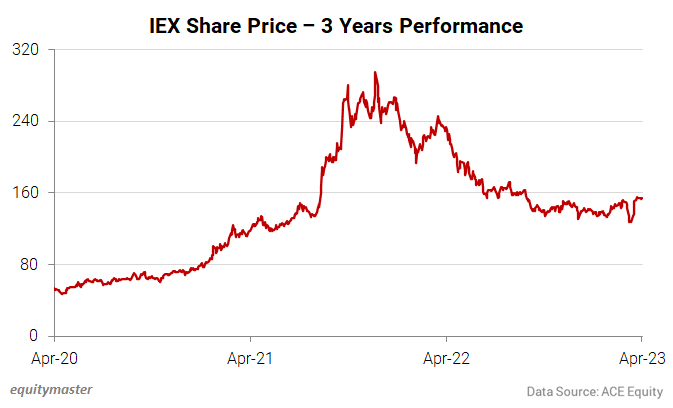
IEX currently has 92% share of the power exchange volumes (35% of short term market). Short term market is 12% of total power traded in the country, So, IEX' market share is slightly below 4%. Even a small growth in short term market volumes can offer a huge fillip to IEX' revenues.
The company's board recently approved a buyback of shares at Rs 200 per share.
To check out the company's financials, visit IEX financial factsheet and IEX latest Q4 results.
#2 Tata Power
Next on this list is Tata Power.
Probably the most talked about stock in recent years, the Tata group company has set forth some ambitious plans for its renewable energy segment.
The company is primarily engaged in the business of power generation, transmission, and distribution through conventional and renewable sources.
In its annual general meeting last year, the company announced a massive investment of Rs 750 bn towards renewable energy.
It aims to double the total capacity from 13.5 gigawatts (GW) in 2022 to over 30 GW by 2027. This expansion will boost its renewable energy portfolio from 34% to 60% by 2027 and 80% by 2030.
That's not all. Tata Power leads the electric vehicle charging station pack with over 1,300 charging stations under its umbrella. Aiming to create a large dedicated electric vehicle battery charging infrastructure, the company plans to become the leader with over 1 lakh chargers installed by 2026.
Currently, Tata Power enjoys a comfortable debt position to support its growth, with a net debt to equity of 1.5x. However, the current interest coverage ratio stands low at 1.6x.
Considering the company is a part of the cash-rich Tata group, funding this new era of growth should not be a concern. The company can either raise more debt or sell more equity to investors across the globe.
In 2023 so far, Tata Power shares are down 7% as outstanding dues have affected its operations. In the past one year, shares of the company have eroded 24% of its marketcap.
The company currently faces tough competition from Reliance Industries and the Adani group and government-funded utilities such as NTPC.
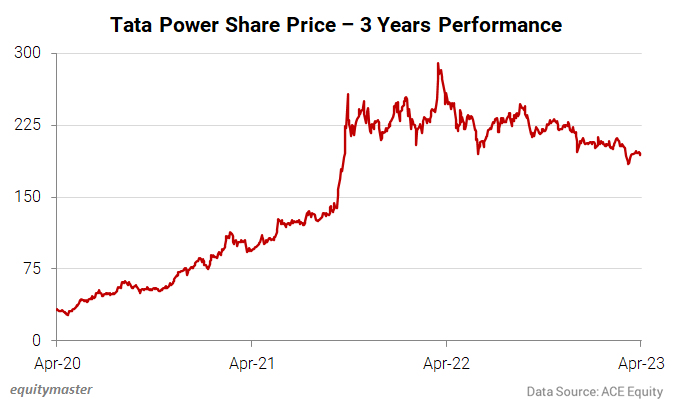
#3 Olectra Greentech
Third on this list is Olectra Greentech.
The company is the largest pure electric bus manufacturing company. It is a pioneer in electric bus manufacturing and has a leading market share of around 35%.
The company has also forayed into the three-wheeler electric autos and electric trucks space.
How does a truck company feature in the list of renewable energy stocks? Turns out, Olectra Greentech has collaborated with Reliance Industries to develop hydrogen buses.
These hydrogen buses are fully carbon-free and will act as prime alternative to the traditional red buses that we see in public transportation. The company said it took this decision in the wake of depletion in natural resources and negative impacts of air pollution and emissions.
Over the years, the company's technological partnership with BYD China, which has the largest fleet of 100% electric buses, has helped in expanding the product portfolio.
With the EV bus market experiencing a higher penetration than other vehicle segments, Olectra's prospects look good.
In the last five years, the company's revenue has grown at a CAGR of 29.3%, driven by higher volumes. The net profit also grew by 31.8% CAGR during the same period.
The company's stock price has been under pressure recently as it lost a big order, but despite that, the company's order book continues to be strong. It has been consistently bagging larger orders for electric buses.
In 2023 so far, shares of the company have gained over 40%. In the past three years, Olectra Greentech shares are up over 8x!
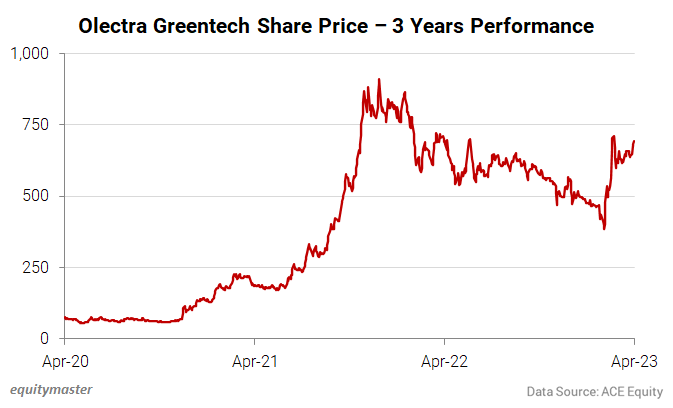
#4 Adani Green Energy
Next on this list is Adani Green Energy.
The Adani group, via its subsidiary Adani Green Energy, has the largest renewable company in India, with a current portfolio of 20 GW.
After witnessing a massive rally in the past two years, the fastest growing stock of 2022 has slowed down in 2023.
And the reasons are not very hard to guess...the Hindenburg report, overleveraged status, and the company being one of the most overvalued stocks in India.
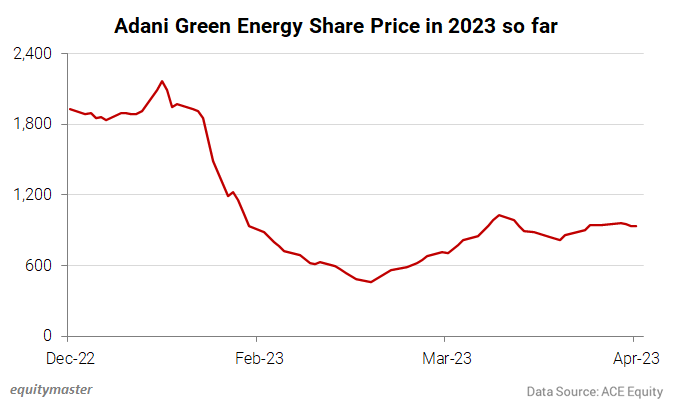
Nevertheless, the company's revenue has increased threefold and has grown at a CAGR of 29.5% in the last five years, owing to higher power generation. It also turned profitable in the financial year 2021 after reporting consistent losses since inception.
In line with the government's renewable energy target of 500 gigawatts (GW) by 2030, the company plans to invest US$ 20 bn (Rs 1.63 trillion) over the next decade to increase its renewable energy target.
If Adani Green Energy plans to fund this through debt, high leverage on the balance sheet will deteriorate the quality of the business, which might affect its performance on the bourses.
Recently, the company logged a massive 49% growth in its operational capacity on a year on year basis.
In fiscal 2023, Adani Green operationalised 2,140 MW solar-wind hybrid power plants in Rajasthan, commissioned a 325 MW wind plant in Madhya Pradesh and a 212 MW solar power plant in Rajasthan.
In the past three years, shares of the company have surged over 350%.
#5 Borosil Renewables
Last on this list is Borosil Renewables.
The company is the first and the only manufacturer of solar glass in India. The glass it manufactures is used in photovoltaic panels. Currently, it has a 40% market share in the domestic market and exports its products to the USA, Turkey, and Europe.
Its current capacity is 450 tons per day (TPD), equivalent to an annual production of 2.5 GW solar modules. The company is adding 550 TPD, operational in 2023, and another 1,100 TPD by 2025. This will increase its total installed capacity to 2100 TPD by 2025.
Apart from this, it's in the process of exploring power sourcing through a hybrid wind-solar plant.
India imports most of its solar glass from China and Malaysia. Being the only domestic solar glass manufacturer, Borosil Renewables benefits from this.
Borosil Renewables stands to benefit from the government's solar mission and the product-linked incentive (PLI) scheme.
Apart from this, high demand for solar panels, anti-dumping duty on solar tempered glass imports, and emerging trends such as EVs will drive the company's growth.
In 2023 so far, shares of the company have fallen 5%. In the past three years, Borosil Renewables share price has gained a massive 1,135%.
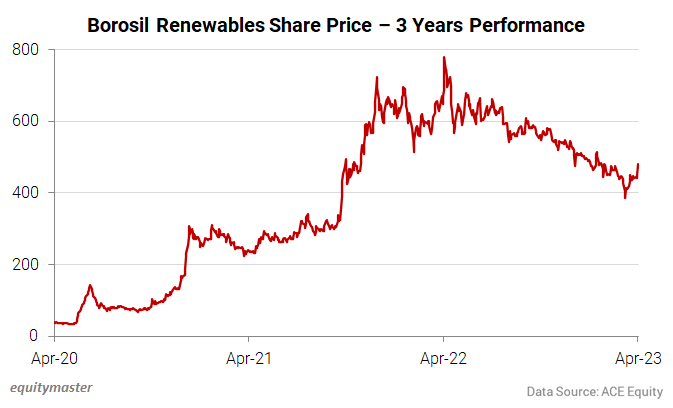
Borosil Renewables is currently focusing on being competitive in the market in terms of cost of production to survive competition from Chinese dumping.
To know more, check out Borosil Renewables financial factsheet and its latest quarterly results.
Performance of top renewable energy stocks in 2023
Though we have discussed only 5 stocks, the list doesn't end here.
Have a look at the table below that shows the performance of other top renewable companies in India.
| Change (%) | 2023 so far | 1 year | 5 years |
|---|---|---|---|
| Sterling and Wilson Renewable Energy Ltd. | 15% | -18% | NM |
| GAIL (India) Ltd. | 13% | -1% | -1% |
| Larsen & Toubro Ltd. | 7% | 32% | 64% |
| Inox Wind Energy Ltd. | 4% | 39% | NM |
| Indian Oil Corporation Ltd. | 2% | -12% | -27% |
| Swelect Energy Systems Ltd. | 2% | -15% | 27% |
| NTPC Ltd. | 2% | 6% | 17% |
| Visaka Industries Ltd. | -8% | -33% | -44% |
| Reliance Industries Ltd. | -8% | -14% | 155% |
| Inox Wind Ltd. | -9% | -14% | -14% |
| JSW Energy Ltd. | -10% | -22% | 211% |
| Orient Green Power Company Ltd. | -14% | -24% | -5% |
| Websol Energy System Ltd. | -17% | -38% | -8% |
| Gita Renewable Energy Ltd. | -27% | -52% | NM |
Happy Investing!
Also check out the below list of renewable energy stocks, which we highlighted in early 2022.
India's Top Renewable Energy Stocks: Big Returns or Boring Returns? (as of 2022)
India and other countries across the globe are rapidly changing their stance and switching to greener power sources.
The renewable theme is gaining pace as India aims to meet 50% of its energy requirement from renewable energy sources by 2030 and reduce its carbon emission by 45%.
The prospect for the renewable energy companies has never looked so brighter.
If the recent developments are anything to go by, it looks like the industry could grow at an even rapid pace than current projections.
Last year in December, we wrote about India's top renewable energy stocks and whether they're giving investors their money's worth.
The top renewable energy stocks have already proven to be value creators and delivered gains if a long term investment perspective is considered.
Take a look at the table below:
Performance of India's Top Renewable Energy Stocks
| Company | CMP (Rs) | YTD (%) | 1 Year (%) | 2 Years (%) | 3 Years (%) |
|---|---|---|---|---|---|
| Adani Enterprises Ltd. | 2293.05 | 34% | 61% | 1370% | 1526% |
| Adani Green Energy Ltd. | 1920.90 | 45% | 92% | 427% | 3788% |
| Borosil Renewables Ltd. | 619.40 | -1% | 128% | 646% | 282% |
| GAIL (India) Ltd. | 137.25 | 6% | -7% | 36% | -7% |
| Indian Oil Corporation Ltd. | 72.70 | -2% | 2% | 25% | -26% |
| JSW Energy Ltd. | 212.20 | -29% | 24% | 362% | 209% |
| Larsen & Toubro Ltd. | 1687.40 | -11% | 12% | 82% | 13% |
| NTPC Ltd. | 143.50 | 15% | 22% | 60% | 11% |
| Reliance Industries Ltd. | 2391.50 | 1% | 15% | 24% | 88% |
| Tata Power Company Ltd. | 220.05 | 0% | 78% | 344% | 226% |
| Websol Energy System Ltd. | 92.40 | -41% | 31% | 354% | 270% |
The above list is still extremely relevant today.
Read on to know more...
India's Top Renewable Energy Stocks
Investing in disruptive and niche businesses has become the investment theme lately.
However, if you think about it, there isn't really anything new about it. This has always been the way of life and businesses.
Wasn't it disruption when wheel was invented or when mobile technology took over? Another example is Netflix and other streaming services disrupting the entertainment industry.
So why now, in this moment, is the theme of 'disruption' taking center stage?
Well, just because it's making the change at a lightning speed now.
Traditional businesses are too big and set in their old ways. And the one industry seeing a huge amount of money being pumped in is the renewable energy space.
Investors are falling head over heels whenever they hear the term 'renewable energy'.
Let's look at the top companies from the renewable energy sector and see if they're giving investors their money's worth.
#1 Tata Power
Tata Power shares are on a dream run this year.
Why? Because this legacy power company is foraying into new-age technologies and the market has factored in the news.
Tata Power is one of India's leading players in the renewable energy space with renewable power capacity of 2.6 gigawatt (GW) in 11 states. It's well-positioned to respond to the shifting landscape of India's renewable energy push.
Tata Power is planning to take its renewable production to massive 15 GW by 2025.
The company is a front-runner across the renewable spectrum through its subsidiaries, Tata Power Renewable Energy, Tata Power Solar Systems (TPSSL), and Walwhan Renewable Energy (WREL).
Apart from renewable energy, Tata Power is acing the EV race. Tata Power has various orders up its sleeve in the electric vehicle (EV) charging stations segment.
Over the past three months, Tata Power share price is up 72%. When compared yearly, the stock is up a whopping 210% in the past 12 months.
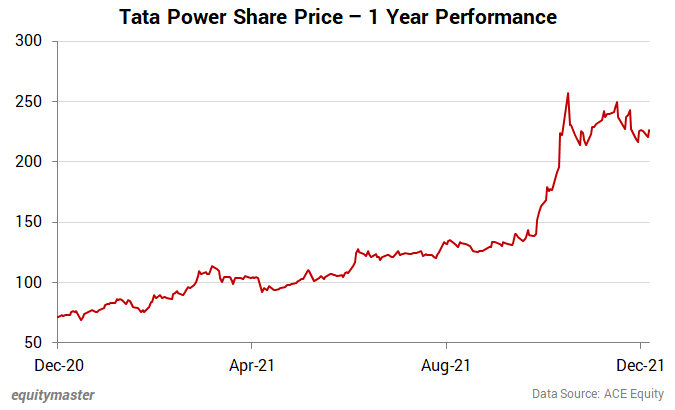
Clearly, these are big returns by any margin.
Co-Head of Research at Equitymaster, Rahul Shah believes the sharp run up in the stock price over the last few months seems to have captured a lot of that upside.
Here's what he wrote...
- Although the prospects look good, the sharp run up in the stock price over the last few months seems to have captured a lot of that upside. In fact, in our view, the markets may have overdone the bullishness a bit.
Thus, if you have not invested in the stock already, it may be a good idea to stagger your purchase and not buy everything in one go.
After all, it pays to be conservative if one has any doubts about the valuation of a stock.
To know more, check out Tata Power company factsheet and Tata Power's latest quarterly results.
Update: Tata Power recently announced a massive investment of Rs 750 towards renewable energy at its latest annual general meeting.
As India prepares to leap forward in developing its renewable energy sources, the company is equipping itself every step of the way.
Read this editorial to know more about Tata Power's big bet on green energy.
#2 Websol Energy Systems
Websol Energy System is a leading manufacturer of photovoltaic monocrystalline solar cells and modules in India.
The company went into business as a fully export-oriented unit catering to Europe (mainly Germany and Italy) and the US.
Keeping in view rapid technological advancement, Websol has invested in cutting-edge developments to manufacture world-class photovoltaic cells and solar modules at its state-of-the-art facility in Falta, SEZ. The facility comprises a production capacity of 250 MW cells and 250 MW modules.
Just like Tata Power, shares of Websol Energy are also on a roll this year.
Over the year gone by, Websol Energy share price is up around 175%. The big returns by the stock are in line with the company's fundamentals. The stock is under pressure this month and has fallen around 8%.
At the current price, the company commands a marketcap of Rs 2.7 bn.
Update: Websol Energy recently announced it will build a new solar cell and module manufacturing plant with a capacity of up to 1.8 GW.
Solar project developers are already interested in buying solar modules which will be built from the new factory.
The solar sector is already hot in India and the competition intensified when Reliance entered the fray.
#3 Borosil Renewables
Borosil Renewables is the first and only solar glass manufacturer in India. It's a proxy play if you want to participate in the solar energy revolution.
The company spotted the opportunity in the segment quite early and commissioned its solar glass manufacturing facility in January 2010.
Amidst the global energy crisis, Borosil Renewables was the major beneficiary. Apart from solar glasses, it has other tailwinds to its business.
The stock has given positive returns across durations. It's yet another example of big returns.
| % Change | 1 Month | 3 Months | 6 Months | 1 Year |
|---|---|---|---|---|
| Borosil Renewables | 20% | 84% | 98% | 326% |
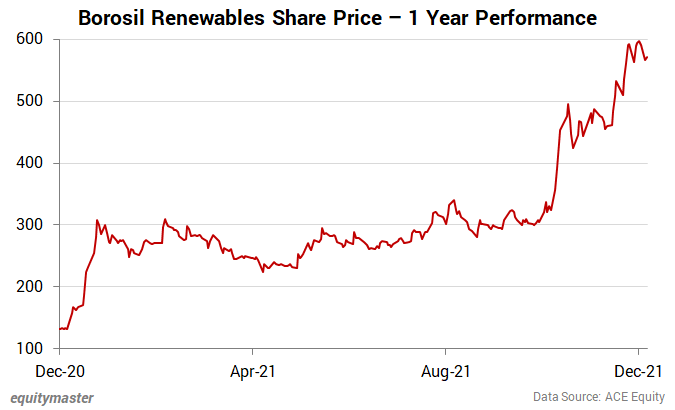
Update: Borosil Renewables is in a sweet spot as India imports majority of the solar glass (around 65%) at present. This leaves more than 30% for Borosil Renewables.
To secure India's needs, Borosil Renewables has planned to increase 5 times more production from the current levels as India goes on a shift to renewables.
The company's management recently told that due to improving government policies and incentives such as the PLI scheme, the shift will be faster than imagined.
#4 NTPC
NTPC has been aggressively pushing for greening its portfolio.
The largest electricity producer in India has pivoted toward green energy as pressure mounts to reduce coal usage because of the fuel's role in global warming and its harmful impact on environment and human health.
The state-owned thermal power company was recently in news as it was planning to list three subsidiary companies on the exchanges - NTPC Vidyut Vyapar Nigam (NVVN), North Eastern Electric Power Corporation (NEEPCO), and the one-year-old NTPC-Renewable Energy (NREL).
NTPC has tied up with IOC for generation and storage of renewable energy or other forms of energy, including gas-based power, primarily to cater for IOC refineries or other installations.
It's also planning to produce green hydrogen on a commercial scale.
The company plans to do that from its upcoming 4,750 MW renewable energy park at the Rann of Kutch. The capacity of the plant will be 5 MW.
Despite all this, the company's stock performance is nothing to write home about. Even in this bull market, NTPC's stock has given 28% return in the past 12 months. In the past one month, the stock has lost about 9%.
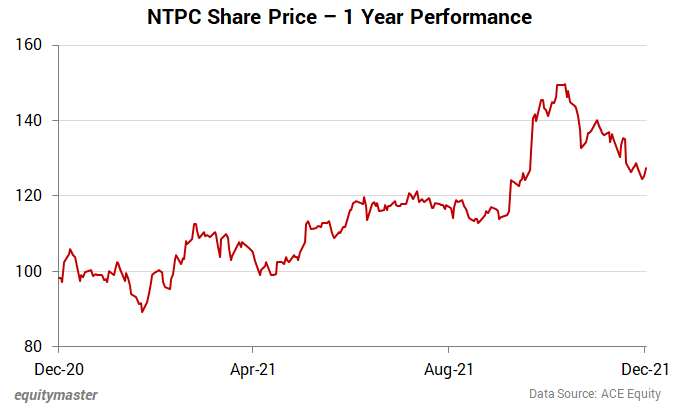
Update: NTPC is currently planning to raise Rs 50 bn by selling a stake in a newly created green energy arm.
It recently planned on hiving off 15 of its renewable energy projects into NTPC Green Energy, a newly formed entity.
#5 Reliance Industries
Reliance Industries has formed a slew of partnerships for its green energy plans. This includes solar, battery, and hydrogen investments.
The oil-to-retail conglomerate announced a wave of partnerships with REC, NexWafe, Sterling and Wilson, Stiesal, and Ambri for an estimated cost of US$1.2 bn.
The company recently announced its plans to become a net carbon-zero firm by 2035. It aims to replace transportation fuels with clean electricity and hydrogen.
Reliance will invest Rs 750 bn over the next three years in renewable energy. Out of this, it will invest Rs 600 bn in a 5,000-acre, green energy integrated complex called Dhirubhai Ambani Green Energy Giga Complex in Jamnagar, Gujarat.
The company's intentions to focus on renewable energy and reduce hydrocarbon footprint became even more evident when it announced its exit from the shale-gas business in North America last month.
Just like NTPC, Reliance's stock performance has been decent. Over the past one year, Reliance Industries share price is up 21% while it is trading near the same level it was trading 3 months ago.
To know more, check out Reliance Industries' latest quarterly results.
Update: Reliance share price is falling for the past couple of days after government decided to levy a windfall tax on domestic crude oil producers.
Some believe this correction has provided investors with a buying opportunity in Reliance.
#6 GAIL (India)
GAIL supports the theme of rising gas penetration in India and government's focus to expand gas as a key energy transition fuel.
In July this year, the company had announced that it will invest Rs 50 bn to build a portfolio of at least 1 GW of renewable energy.
The PSU also plans to build India's largest green hydrogen plant as it looks to supplement its natural gas business with carbon-free fuel. Even as the company has ambitious plans with respect to renewable energy, the stock performance says otherwise.
Here's how the stock has performed over different time durations.
| % Change | 1 Month | 3 Months | 6 Months | 1 Year |
|---|---|---|---|---|
| GAIL (India) | -11% | -8% | -21% | 10% |
Clearly, these are boring returns.
#7 Indian Oil Corp (IOC)
Last month, two PSU behemoths Indian Oil Corporation (IOC) and NTPC signed a memorandum of understanding to together explore and collaborate in the renewable energy sector.
If all goes according to plan, the two companies will jointly build generation and storage of renewable energy or other cleaner forms of energy, including gas-based power, primarily to cater for IOC's refineries and other installations.
IOC's stock performance has been decent as it has gained 28% over the year gone by.
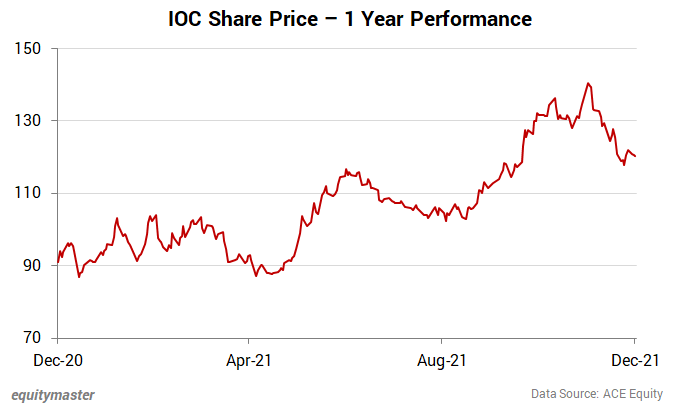
#8 L&T
Engineering major L&T has also forayed into the green hydrogen space.
Last week, L&T and renewable energy developer ReNew Power partnered to tap the emerging green hydrogen business in India. Under the partnership agreement, L&T and ReNew will jointly develop, own, execute and operate green hydrogen projects in India.
In its latest annual report, L&T said it aims to be net-zero emissions by 2040. 90% of this would come from switching over to initiatives such as renewable energy, green hydrogen, and biodiesel while the other 10% would be offset by creating carbon sinks.
The company plans to spend between Rs 10-50 bn on its green initiatives, over several years.
Shares of L&T have been in an upward trend since the start of this year, barring a few hiccups in March 2021. The stock is up 57% in the year gone by and 11% in the past three months.
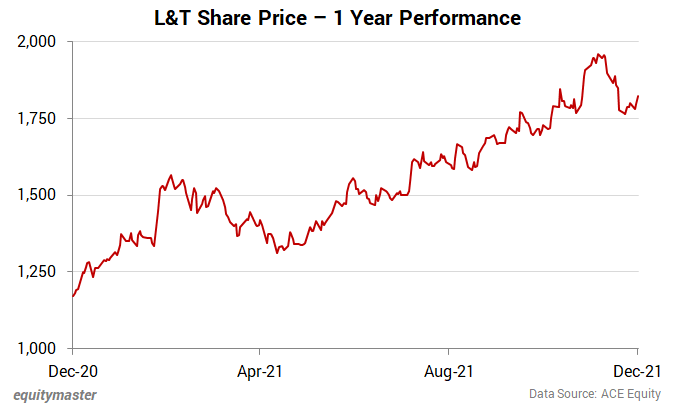
#9 JSW Energy
JSW Energy share price has outperformed all the above-mentioned stocks by a good margin.
From trading at Rs 65 a year ago, JSW Energy currently trades at Rs 300 per share. That's a 360% gain in just one year.

Two weeks back, the company decided to restructure its renewables business. You can read the recent development taking place in the firm here.
Through this strategic stake sale in its green energy business, the company aims to catch up with peers such as Tata Power and Adani Power that have stepped up investments into non-conventional energy.
#10 Adani Group Stocks
It was in September this year when the Adani group decided to take on Reliance Industries.
Billionaire Gautam Adani has made it clear he has big plans for this space. He recently announced plans to invest up to US$70 bn (Rs 5.3 tn) in renewable energy over the next decade and produce the cheapest green hydrogen in the world.
In fact, he plans to invest the money across the entire green energy value chain.
To increase its presence in clean energy space, recently, Gautam Adani, chairperson of Adani Group, sealed the largest deal in India's renewable sector with acquisition of SB Energy for US$3.5 bn.
Here's how Adani group stocks have performed over the past one year.
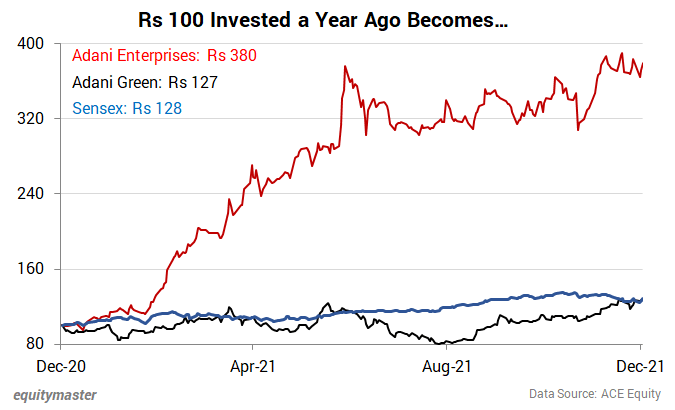
Update: In June 2022, French giant TotalEnergies announced to buy a quarter of the equity in Adani New Industries.
Disclosing the details, the Adani group chairman Gautam Adani said Adani New Industries will invest US$50 bn over 10 years in green hydrogen and for starters, build a production capacity of 1 m tonnes a year.
#11 Sterling & Wilson Solar
Sterling and Wilson Solar is a global end-to-end solar engineering, procurement, and construction (EPC) solutions provider.
The stock has been in the news of late as Reliance Industries' wholly-owned subsidiary Reliance New Energy Solar agreed to acquire up to 40% stake in Sterling & Wilson for approximately a total pay-out of Rs 28.5 bn.
Shares of the company started to gain traction on the bourses a month before the deal was announced. Before that, the stock was trading in a range throughout the year.
Shares of the company have gained 50% in the year gone by while over the past one month, the stock has been under pressure, falling 10%.
An important factor one should note here is that Sterling and Wilson's profitability continues to remain impacted due to challenging environment across the entire solar industry value chain.
Sterling & Wilson Solar reported a consolidated net loss of Rs 2.8 bn for September quarter 2021-22. For financial year 2021, the company posted a loss of Rs 2,900 m after three consecutive years of profits.
To know more, check out Sterling & Wilson's factsheet and latest quarterly results.
Why renewable energy stocks will benefit in 2022 and beyond...
We're witnessing a disruptive shift in the energy landscape given the market's newfound love for all things 'green'.
Investors are falling head over heels whenever they hear the term 'renewable energy'.
And rightly so.
You'll agree when we say energy transition from fossil fuels towards greener, more environmentally-friendly sources is set to be the biggest investment theme of this decade.
Big corporates of Ambani and Adani have already announced plans for multi-billion dollar investments in renewable energy to ensure India moves closer towards its net-zero target.
Even the investing legend Charlie Munger is bullish on renewable energy.
Recently, Munger told that he is bullish on renewable energy and loves the fact that countries are rapidly reducing the burning of coal and the burning of gasoline and diesel.
Here's Munger in his own words:
- I would be in favour of using a lot more renewable energy from wind and solar, even if there were no global warming problem.
I think saving the hydrocarbons for future generations instead of blowing them all in one big blast, would be a very smart thing to do even if there were no global warming.
As India goes on a seismic shift where traditional energy sources get replaced by green energy like solar, wind, and green hydrogen, there's massive scope.
No wonder why India's investments in renewable energy has accelerated in the recent years.
Disclaimer: This article is for information purposes only. It is not a stock recommendation and should not be treated as such. Learn more about our recommendation services here...

Yash Vora is a financial writer with the Microcap Millionaires team at Equitymaster. He has followed the stock markets right from his early college days. So, Yash has a keen eye for the big market movers. His clear and crisp writeups offer sharp insights on market moving stocks, fund flows, economic data and IPOs. When not looking at stocks, Yash loves a game of table tennis or chess.
Equitymaster requests your view! Post a comment on "India's Top Renewable Energy Stocks: Big Returns or Boring Returns?". Click here!
1 Responses to "India's Top Renewable Energy Stocks: Big Returns or Boring Returns?"


Manoj K Jain
Oct 5, 2022Please also mention new and upcoming companies or small companies in RE and Power sector , showing good and positive results.